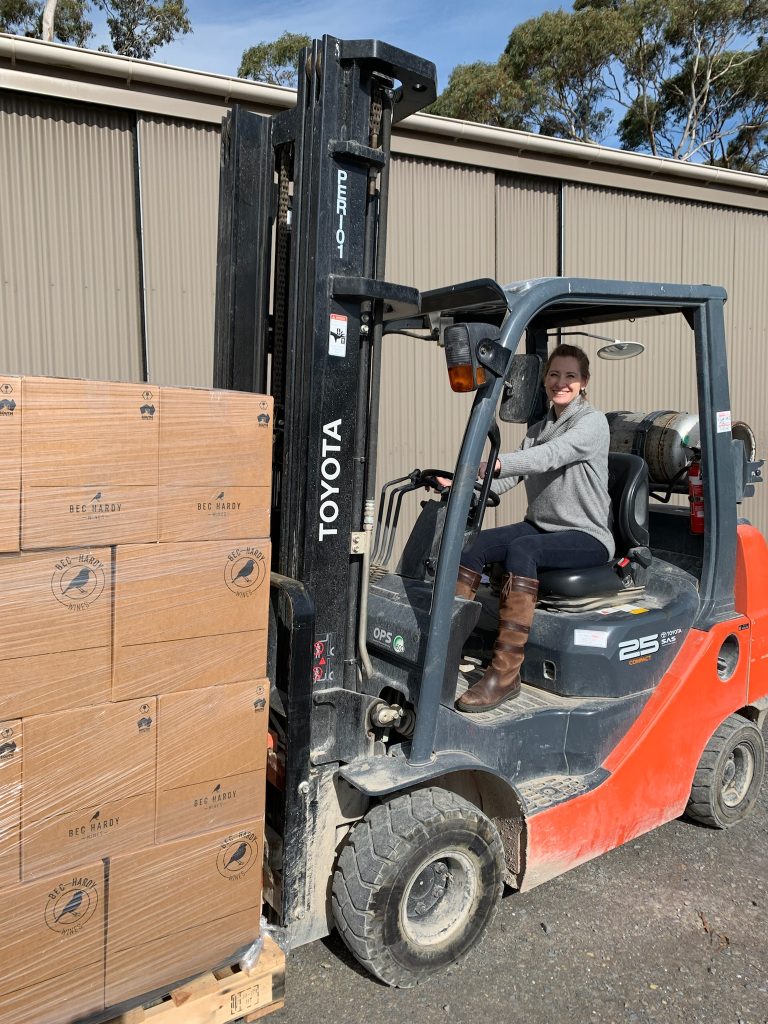The pandemic has impacted industries around the world, with the Australian wine sector being hit hard. But despite cellar doors, and regional tourism, remaining shuttered in a number of regions, businesses have found ways to keep sales afloat, including by boosting their digital footprints. Journalist Samuel Squire provides a snapshot of the state of the promising DtC market in Australia, explores where cellar door opportunities lie, and where producers are left in the post-China global export space.

Direct-to-consumer sales
Direct-to-consumer (DtC) has, over the course of the ongoing COVID-19 pandemic, become a market norm for many customers, and has become a primary sales avenue for many businesses to keep afloat during this period.
To meet consumer demand, many businesses have innovated their wine club offerings, technologies and have made efforts to expand and grow their DtC and export channels.
One such business, Bec Hardy Wines – a top exporter of South Australian wine overseas, has recently been named as the state’s Regional Exporter of the Year at the Premier’s export awards.
Richard Dolan, Bec Hardy Wines co-owner, says the business’ DtC market growth over the course of the pandemic has been mounting stronger and is still strengthening.
“We’re seeing record numbers of online sales, very strong wine club sign-ups and successful sales campaigns,” he said.
“We’re investing in new technology, external marketing assistance, brand research and PR.”
Dolan says one key aspect for the success and growth of the business’ DtC market channel is likely due to the brand itself and the history behind it.
“We have an authentic brand with a unique history and heritage and wines that over-deliver on price to quality ratio and we’re confident greater investment in DtC will pay dividends,” he said.
As DtC has increased as a mainstream channel for businesses to reach their customers, a unique problem has arisen, Dolan says.
“The move to support local was certainly there at the start of the pandemic, but as pandemic fatigue has set in, I think that movement has declined somewhat,” he said.
“People are certainly more inclined to buy online for contactless delivery [and one of the challenges we face is] resourcing the warehouse to keep up with orders – it’s a nice problem to have!”
Wine Australia’s recently released DtC survey report suggests Australian wine DtC sales in 2020–21 are reported to have grown by 17 per cent in value and 14% in volume, compared with the previous financial year, outperforming other sales channels.
Across all DtC channels, the average retail sales value for survey respondents in 2020–21 was up 3% to $239 per case.
Wine Australia general manager, corporate affairs and regulation Rachel Triggs said that this was a positive response given the difficult conditions for businesses in 2020–21.
“Survey respondents reported that overall wine sales grew by just 1%, so it was particularly pleasing to see a significant increase in DtC sales this year,” said Triggs.
Online and cellar door sales were reported to have had the strongest value growth of the DtC channels in 2020–21.
The survey showed cellar door sales revenue grew by 22%, while online sales grew by 23%. However, there was a drop in the average case value for online sales (down 14%), whereas the average value per case for cellar door sales increased by 16%.
“The report suggests that in regions not significantly impacted by COVID-19 restrictions, cellar doors performed well this year,” said Triggs.
“Wineries reported adapting their business models to suit COVID-19 conditions, providing more tailored experiences for visitors that improved profitability.”
Responses to Wine Australia’s survey showed the average 9-litre case value also declined – down 5% to $262 – while average value per member declined by 14% as a result of the reduced average case value combined with a slight reduction in shipments per member.
Triggs noted that, generally, a decline in average case value indicates reduced profitability – unless the cost of the product also reduces.
“The survey found that more than 60% of respondents were offering discounts of 11–20% on wine club orders, which suggests that this channel is very competitive,” she said.
Survey respondents reported database sales also increased in 2020–21, growing by 15% in value and 4% in average case value.
WithWine, a company specialising and operating in the DtC space, says the Australian wine sector has had to conduct some “soul searching” over the course of the pandemic.
Founder and CEO of WithWine Richard Owens says the pain delivered by China and the imbalance of domestic wine trade caused by the pandemic shutdowns have left many winery owners wondering how they can control their future.
“This has been a soul-searching year for the Australian Wine Industry,” said Owens.
“The Direct-to-Consumer (DtC) channel offers a more personalised, profitable and reliable way of selling wine.
“Australian consumers, generally, are also more used to buying brands online. DtC promises to become a key feature of wine distribution.”
Owens went on to say that the pandemic was a curve ball for the nation’s wine producers, and while innovation can be slow in the industry, it happened promptly to respond to the difficulties of the pandemic.
“The wine industry is inclined to be cautious and slow at innovation,” said Owens, “Many wine businesses were completely unprepared for the shocks of the last few years”.
“However, wine people are also great at dealing with crises. Numerous producers adapted very quickly to the spectre of lockdowns, restaurant closures and the loss of the China market.
“I think wineries are making a huge effort to build rapport with their direct customers, but of course some are doing it better than others.
“The concept of using technology and data to drive wine sales can be overwhelming, but ultimately the wine industry knows it needs to adapt.
“The interest in our WithWine platform has grown markedly over the last 18 months as wineries search for ways to build resilience in their business, improve margins and profitability,” continued Owens.
“The DtC market has come of age in the last 18 months, and we believe it will continue to expand significantly.”
WithWine has had to, like all wine businesses, adapt to the new normal. But considering the company operates in DtC markets, this was a growth opportunity.
“At WithWine, we have witnessed a significant upwelling of interest and growth in our services,” said Owens.
“Looking back, I am really pleased we invested in getting our DtC technology in a solid place before the pandemic.
“The functionality and interoperability are excellent and the WithWine platform is easy to use and cost effective.
“We are thrilled that our business model has attracted solid and supportive investors as well. This has enabled us to build an excellent team comprising some great tech developers and wine people.
“Our business has more than doubled in size in response to the potential of WithWine and the DtC market.”
Owens concluded that his outlook for Australia’s DtC market is promising and hopeful.
“I would like to think the Australian wine Industry will be in a better position to manage its future,” he said.
“Data and technology will be the principal drivers of change across many aspects of viticulture, winemaking and wine business.
“I am convinced that the DtC market will become increasingly valuable and powerful. It replicates and enhances the cellar door experience, gives control over margins and profitability, and promotes a direct relationship with the customer.
“I feel very optimistic that WithWine will become a key player in this space.”
Cellar door sales
Owens maintained that cellar door performances had become more critical to wine businesses than previously thought.
“Cellar door operations became massively important,” he said.
“Before the pandemic, many wineries were happy with one-off cellar door sales. Simplistically, they would focus on how much money a customer might have in their wallet to spend that day, rather than whether the same customer might become a repeat buyer several times during the year. But the outlook has shifted.
“Growing a database of customers and engaging with it effectively is everyone’s new priority. Establishing close relationships with the customer and building repeat business are now priorities for wineries of all sizes and types.”
In South Australia, Dolan says that, at the time of writing, residents are not currently subjected to stay at home orders by the State Government, but building relationships with consumers whilst able to do so is a key way to help improve sales if the state’s COVID status changes negatively.
Dolan adds that the business has been investing in its cellar door to upgrade facilities and improve the experience with future investment planned.
“While we here in South Australia are not currently experiencing stay at home measures, locals are keen to get out and about and enjoy the cellar door experience, so there is an opportunity there to connect with visitors and create brand fans,” he said.
“Even if visitors are not buying significant quantities in the cellar door, we have been implementing a number of marketing strategies to connect with them, and keep the relationship going after they’ve left the winery.”
The business has noted a ramp-up in wine club sign-ups, according to Dolan, and has had to adjust to accommodate that growth.
“We continue to recruit to the wine club at a rate faster than we anticipated through our cellar door, which has been enjoying growing increased footfall,” said Dolan.
“We’ve scaled up our communications and marketing to club members to ensure we keep these loyal brand fans engaged and responding positively to the added value it offers.
“I think the authenticity of the brand, the connection that people make with Bec and I at the cellar door, and the broad range of initiatives we’ve undertaken over the last fifteen months since acquiring the majority of the Geoff Hardy business, is really paying dividends for us.”
Wine Australia’s DtC survey report also suggests the share of seated tastings also increased significantly, up from 44% in 2019–20 to 66% in 2020–21, and 71% of respondents said that bookings were encouraged for all tastings (although not mandatory).
While cellar door sales have improved, Wine Australia’s survey also showed winery-owned wine clubs have struggled. Although wine club sales revenue was reported to have grown by 10% in 2020–21, wine clubs’ share of DtC declined from 21% to 19%.
The average number of database contacts also increased, and the frequency of communication with contacts jumped substantially in the past two years, with the proportion of respondents sending communications at least bi-monthly increasing from 39% in 2018–19 to 60% in 2020–21.
Triggs noted that the survey results were only part of the picture.
“The survey has given us an important insight into how some wineries have managed the first full year of ‘living with COVID-19’, but the sample is small, and there are a wide range of experiences across the country that are not reflected in overall averages,” she said.
“The important thing for wineries is to measure their own performance regularly, so they know which channels are doing well and where investment will be most beneficial.”

Export markets and opportunities
Dolan says the business is positioned well in its export market too, and with additional funding through the SA Export Accelerator Program grant, the business has also become one of 28 SA companies to be chosen for a state-level global expansion program.
“Funding through the SA Department of Trade and Investment and their SA Export Accelerator Program assisted us in the appointment of an in-market consultant in the US,” said Dolan.
“Now as one of only 28 South Australian companies to be chosen for the SA Global Expansion Program, we’ve recently appointed an in-market consultant in the UK to connect us to distribution there.
“That support though is not limited to financial assistance,” he added, “Access to Austrade business development managers (BDM) and South Australian in-market BDMs has been invaluable”.
“At home, our Tradestart adviser, Justin Harman, is a wonderful point of contact to access all of this invaluable support.”
The elephant in the room for any exporting wine business remains the Chinese market. This market, according to Dolan, Bec Hardy Wines remains optimistic that the biggest market for Australian wine will reopen its borders.
“China remains an exciting long-term prospect for Australian wine,” he said.
“We look forward to being back in-market once borders are re-opened to continue to support our network of distributors there, some of whom still have product.”
Prior to the imposition of tariffs, Dolan said the business had long considered the market in China wouldn’t be sustained forever, and adds that all things are cyclical and bust inevitably follows boom.
“We had, therefore, an export distribution strategy ready to go as soon as we completed our acquisition of the majority of the Geoff Hardy business that wasn’t focussed on one market particularly,” he said.
“We still have lots of work to do. We’re looking to improve our domestic distribution and looking to recruit new importers in mainland Europe as well as expand our distribution in the US now we have created a beachhead.”
.
This post was originally featured in the November 2021 issue of the Grapegrower & Winemaker.
To read more articles like this, subscribe online here.
















